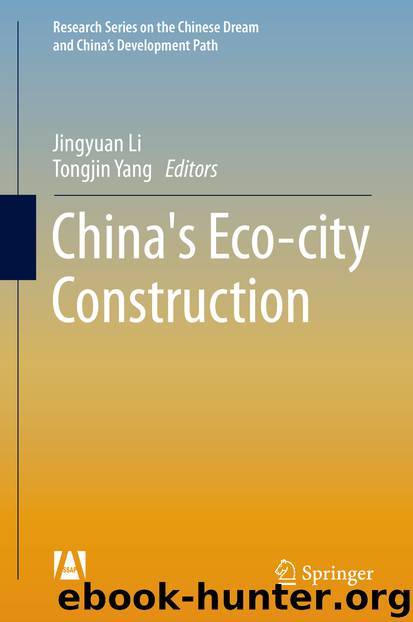China's Eco-city Construction by Jingyuan Li & Tongjin Yang

Author:Jingyuan Li & Tongjin Yang
Language: eng
Format: epub
Publisher: Springer Berlin Heidelberg, Berlin, Heidelberg
The NDRC, the MOHURD, the Tianjin Municipal Government, and the China Center for International Economic Exchanges (CCIEE) held the Second China (Binhai Tianjin) International Eco-city Forum & Expo (Binhai Forum) on September 23–24, 2011. NDRC Deputy Director Xie Zhenhua attended the opening ceremony and delivered a keynote speech titled “Promote opportunities through green low-carbon development for low-carbon cities” at the main forum, proposing a number of measures for low-carbon cities. (1) He proposed optimizing the industry mix; developing the service sector and emerging strategic industries such as energy conservation, environmental protection, and new energies; and preventing energy-intensive, high-emission industries from rapid growth. Enhancing binding targets for energy conservation, environmental protection, land use, and safety, eliminating obsolete production equipment and technologies, and promoting the transformation of traditional industries for an energy-efficient, low-carbon industrial system further aid optimization. (2) He recommended optimizing the energy mix, controlling total energy consumption, strengthening cleaner production and coal use, and developing clean, efficient, high-capacity coal-fired generation units. Further steps include increasing oil and gas exploration and development, developing unconventional oil and gas resources, and developing nonfossil energy sources. Safe nuclear power, eco-friendly hydropower, wind power, solar power, biomass, geothermal energy, and other renewable energy sources can be developed based on local conditions. (3) He proposed strengthened energy conservation and low-carbon development management, energy efficiency benchmarking activities, and energy conservation and emission reduction projects in buildings, transportation, and other sectors. The “10,000 low-carbon businesses” initiative can help the industrial sector, the “green building” initiative can help the construction industry, and the “1,000 low-carbon transportation companies” initiative can help the transportation sector. Energy conservation and emission reduction can be better applied in agriculture, rural areas, commerce, households, and public institutions, and low-carbon projects are needed across society, including building low-carbon governments, campuses, and avenues. (4) He recommended accelerating research, development, and application of low-carbon technologies, strengthening basic scientific research on greenhouse gas emissions control, and researching and developing of cutting-edge technologies critical to reducing carbon. Governments should offer incentives for the broad application of energy conservation and carbon reduction technologies and equipment and support energy-efficient motors, semiconductor lighting, low-frequency waste heat utilization, and other important low-carbon technologies to advance their production and application.16
Download
This site does not store any files on its server. We only index and link to content provided by other sites. Please contact the content providers to delete copyright contents if any and email us, we'll remove relevant links or contents immediately.
The Brazilian Economy since the Great Financial Crisis of 20072008 by Philip Arestis Carolina Troncoso Baltar & Daniela Magalhães Prates(117794)
International Integration of the Brazilian Economy by Elias C. Grivoyannis(87643)
The Art of Coaching by Elena Aguilar(52869)
Flexible Working by Dale Gemma;(23238)
How to Stop Living Paycheck to Paycheck by Avery Breyer(19614)
The Acquirer's Multiple: How the Billionaire Contrarians of Deep Value Beat the Market by Tobias Carlisle(12206)
Thinking, Fast and Slow by Kahneman Daniel(12011)
The Radium Girls by Kate Moore(11891)
The Art of Thinking Clearly by Rolf Dobelli(10167)
Hit Refresh by Satya Nadella(9011)
The Compound Effect by Darren Hardy(8768)
Tools of Titans by Timothy Ferriss(8178)
Atomic Habits: Tiny Changes, Remarkable Results by James Clear(8149)
Turbulence by E. J. Noyes(7913)
A Court of Wings and Ruin by Sarah J. Maas(7601)
Change Your Questions, Change Your Life by Marilee Adams(7595)
Nudge - Improving Decisions about Health, Wealth, and Happiness by Thaler Sunstein(7514)
How to Be a Bawse: A Guide to Conquering Life by Lilly Singh(7359)
Win Bigly by Scott Adams(7063)
